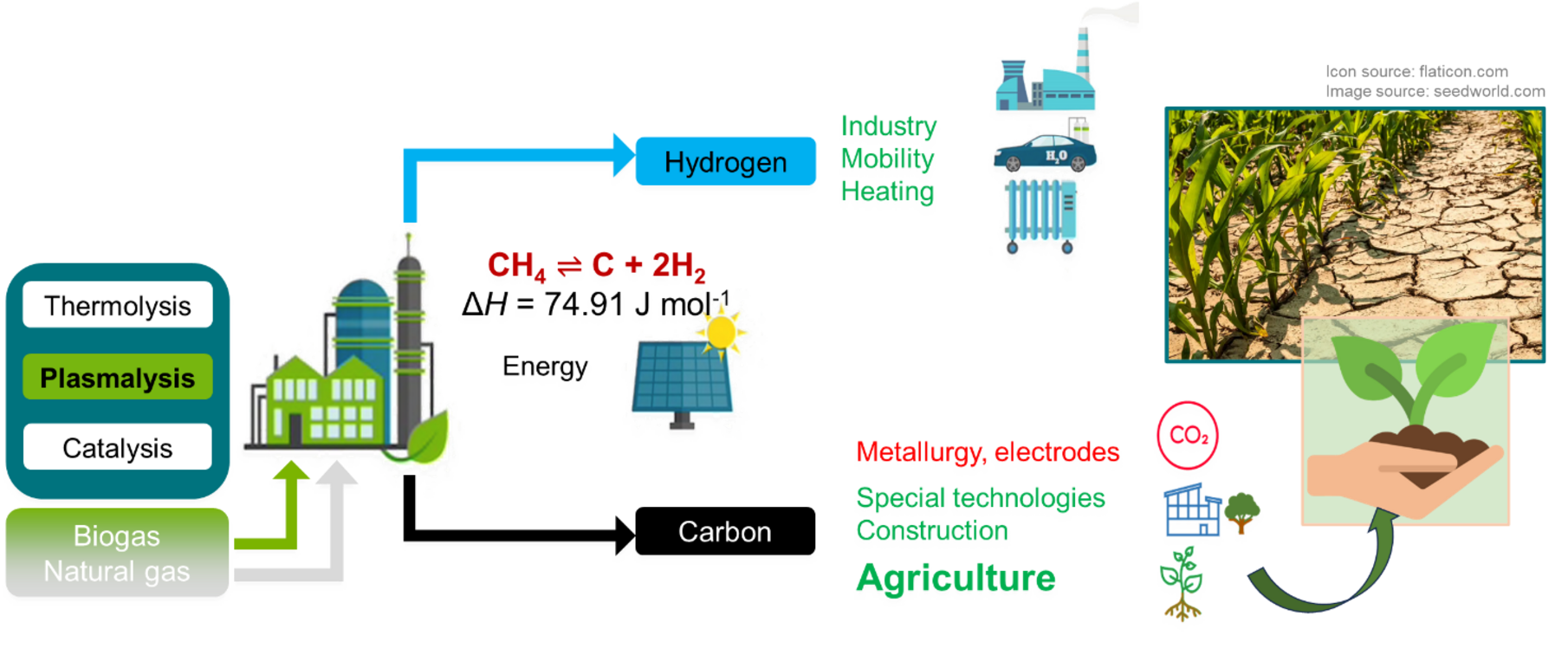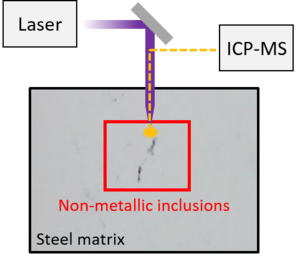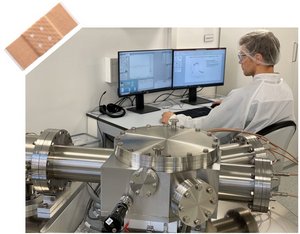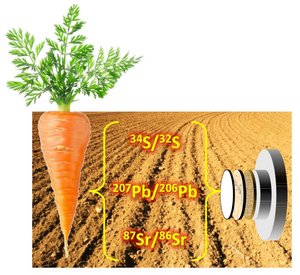AG Technologie und Metrologie
Die Arbeitsgruppe Metrologie und Technologie beschäftigt sich sowohl mit der Entwicklung neuer und innovativer Analysenwerkzeuge und -technologien als auch mit der Umsetzung fundamentaler metrologischer Grundsätze der Analytischen Chemie. Innovative Analysewerkzeuge und -technologien werden dafür entwickelt und bewertet. Neue messtechnische Prinzipien werden validiert und auf analytische Routinen übertragen.
Current projects
Investigation of the effects of carbon from methane plasmalysis on soil characteristics and plant growth
Abstract: During the plasma-based electrolysis (plasmalysis) of methane (CH4) to produce hydrogen (H2), large quantities of elemental carbon (C) are formed. This novel carbon material (abbreviated as CMP - Carbon from Methane Plasmalysis) can be used for various applications. One promising field of application is agricultural crop production, where the incorporation of CMP into the soil - analogous to the traditionally used biochar - could make an important contribution to the development of resource-efficient agriculture and to safeguarding natural soil functions under increasing stress due to climate change. In this context, the aim of this collaborative project is to (1) characterize the physico-chemical properties of CMP, (2) develop novel CMP-based materials for enhanced applicability in agricultural applications, and (3) carry out plant experiments both under controlled and under field conditions with CMP as soil additive. Using state-of-the-art analytical techniques at the Chair of General and Analytical Chemistry, detailed insight into the physical, chemical, and biological effects of CMP on soil characteristics and plant growth will be obtained, potentially providing a new approach for resilient agriculture ensuring sustainable food safety.
Project funding: RAG Austria AG
Project partners: University of Natural Resources and Life Sciences Vienna (BOKU),Natur - Umwelt - Nachhaltigkeit e.U., Austrian Institute of Technology (AIT)
Project start: January 2021
Team-MUL: Nadine Abu Zahra, Donata Bandoniene, Gerald Hartig, Robert Obenaus-Emler, Stefan Wagner, Thomas Prohaska (PI)
Team-Cooperating institutions: Markus Puschenreiter (BOKU, Natur - Umwelt - Nachhaltigkeit e.U.), Inge Strodl (Natur - Umwelt - Nachhaltigkeit e.U.), Rebecca Hood-Nowotny (BOKU), Gerhard Soja (BOKU, AIT)
Graphical abstract:

Abstract: The project aims at tracing the origin of non-metallic inclusions in steel in the micro- to meso-size range (≥1 µm to <100 µm), which are considered critical in the production of high purity steels for technological applications. For this purpose, the elemental and isotopic compositions of inclusion particles and their potential sources will be assessed using inductively coupled plasma mass spectrometry (ICP-MS) and chemometric methods. Direct solid analysis of inclusions at the microscale will be performed by laser ablation (LA) ICP-MS. Specifically, patterns of trace element profiles, natural isotopic variation, and enriched stable isotope tracers in inclusions will be determined and compared to their corresponding patterns in precursor materials in the production process. It will be evaluated if these data can be used as specific fingerprint to identify and, ideally, to quantify the sources and their contributions to the formation of inclusions in steel.
Project funding: Austrian Federal Ministry of Labour and Economy; the National Foundation for Research, Technology and Development; and the Christian Doppler Research Association
Project lead: Susanne Michelic, Christian Doppler Laboratory for Inclusion Metallurgy in Advanced Steelmaking, Montanuniversität Leoben
Project start: September 2021
Team-MUL: Johanna Irrgeher,Thomas Meisel, Gulnaz Mukhametzianova,Thomas Prohaska, Kathrin Thiele, Stefan Wagner, Christoph Walkner, Susanne Michelic (PI)
Project webpage:
Publications:
- K. Thiele, C. Truschner, C. Walkner, T.C. Meisel, S. Ilie, R. Rössler and S.K. Michelic, Investigating the Origin of Non-Metallic Inclusions in Ti-Stabilized ULC Steels Using Different Tracing Techniques. Metals 14 (2024), 1, pp. 103. https://doi.org/10.3390/met14010103
- K. Thiele, R. Musi, T. Prohaska, J. Irrgeher and S.K. Michelic, AI assisted steel cleanness evaluation: Predicting the morphology of La-traced non-metallic inclusions using backscattered-electron images. Journal of Materials Research and Technology 28 (2023), pp. 2247-2257. https://doi.org/10.1016/j.jmrt.2023.12.172
- K. Thiele, S. Ilie, R. Roessler, C. Walkner, T.C. Meisel, T. Prohaska and S.K. Michelic, Different Approaches to Trace the Source of Non-metallic Inclusions in Steel. Iron & Steel Technology 20 (2023), 7. https://doi.org/10.33313/531/010
Media coverage:
https://www.just-magazin.com/science/mul-hilft-stahl-reiner-zu-machen/
https://www.diepresse.com/6062311/neues-cd-labor-fuer-innovative-stahlerzeugung-in-leoben
Graphical abstract:

Abstract: Metal hyperaccumulation is a fascinating phenomenon. About 1% of higher plant species can accumulate 100-1000 times higher concentrations of trace elements than “normal” or non-accumulating plant species in their aboveground tissues without showing any symptoms of toxicity. Most of these species accumulate nickel, whereas the accumulation of other elements (e.g. arsenic, cadmium, zinc) is much less frequent. While physiological and molecular processes have already been investigated in depth, Ni solubilisation processes in the rhizosphere are still largely unknown.
Novel rhizosphere research methods, including root exudate analysis from soil grown plants, in situ solute imaging at high spatial resolution, and high-end isotope ratio analytics may offer new opportunities for gaining detailed insight into biogeochemical processes in the rhizosphere of Nickel hyperaccumulators.
This project aims to elucidate plant/microbe induced Nickel solubilisation mechanisms by assessing biogeochemical changes in the rhizosphere induced by roots and associated microorganisms. Isotope ratio analysis will be developed and implemented as a novel tool in rhizosphere research and applied for determining the major soil Ni pools acting as a source for plant-available nickel.
Project funding: FWF Austrian Science Fund – Principle Investigator Projects (Grant-DOI 10.55776/P34719)
Project lead: Markus Puschenreiter, University of Natural Resources and Life Sciences Vienna (BOKU)
Project partners: University of Natural Resources and Life Sciences Vienna (BOKU)
Project start: September 2021
Team-MUL: Alexander Epov, Stepan Chernonozhkin,Johanna Irrgeher, Stefan Wagner, Thomas Prohaska (PI)
Team-Cooperating institutions: Markus Puschenreiter (PI-BOKU), Alice Tognacchini (BOKU), Olivier Donard (PAU, CNRS)
Project webpage: https://www.fwf.ac.at/en/research-radar/10.55776/P34719
Publications:
- Risse, S.B.L., Puschenreiter, M., Tognacchini, A. Rhizosphere processes by the nickel hyperaccumulator Odontarrhena chalcidica suggest Ni mobilization. Plant and Soil, 2024, 495, 43-56. https://doi.org/10.1007/s11104-023-06161-w
Graphical abstract:

Abstract: The aim of this project is to develop diffusive gradients in thin films (DGT) technologies to assess localized degradation processes of technological materials during corrosion in aqueous environments. By integrating passive solute sampling through DGT with spatially resolved chemical analysis via LA-ICP-MS, this method development enables the visualization and quantification of elemental solute release at ultra-trace levels and with high (sub-100 µm) spatial resolution. Consequently, it addresses the constraints of existing surface-sensitive analysis techniques in materials sciences, which are limited to visualizing surface alterations without detecting localized elemental solubilization processes in situ, i.e., while corrosion takes place. This advancement offers significant benefits to researchers and engineers across various disciplines by supporting the design of corrosion-resistant materials, thereby enhancing technological safety and sustainability.
Project partners: University of Natural Resources and Life Sciences Vienna (BOKU)
Project start: January 2019
Team-MUL: Stefan Wagner, Gulnaz Mukhametzianova, Gregor Mori, Thomas Prohaska (PI)
Team-Cooperating institutions: Christina Hummel (BOKU),Jakob Santner (BOKU), Markus Puschenreiter (BOKU)
Publications:
- Mukhametzianova, G., Wagner, S., Eskinja, M., Moshtaghi, M., Mori, G., Prohaska, T. Mapping elemental solutes at sub-picogram levels during aqueous corrosion of Al alloys using diffusive gradients in thin-films (DGT) with LA-ICP-MS. Analytical and Bioanalytical Chemistry, 2024. https://doi.org/10.1007/s00216-024-05288-8
- Wagner, S., Hummel, C., Santner, J., Puschenreiter, M., Irrgeher, J., Wenzel, W. W., Borisov, S. M., Prohaska, T. In situ spatiotemporal solute imaging of metal corrosion on the example of magnesium. Analytica Chimica Acta, 2022, 1212, 339910. https://doi.org/10.1016/j.aca.2022.339910
Graphical abstract:

Abstract: Medical diagnoses rely heavily on biomarkers, which serve as specific indicators of an individual's health status. Trace elements are integral to this process, yet their analysis traditionally necessitated invasive blood or tissue sampling. The primary objective of this project is to develop biocompatible skin patches based on the diffusive gradients in thin-films (DGT) technique, thereby pioneering a novel diagnostic tool for the non-invasive, rapid, and quantitative assessment of various trace elements – iron (Fe), nickel (Ni), copper (Cu), zinc (Zn), cadmium (Cd), and lead (Pb) – as biomarkers present in minute amounts of sweat on human skin. This innovative approach combines the selective, time-integrated, and spatially resolved sampling capabilities of DGT with the exceptional sensitivity and precision of inductively coupled plasma mass spectrometry (ICP-MS), thus marking the first application of such a combination within the realm of medicine. As a result, this method development promises to unlock entirely new insights into the potential of trace elements and their isotopes in sweat as biomarkers, potentially enabling the acquisition of a wealth of information about the health status of patients, all from a single drop of sweat.
Project funding: Land Steiermark – Call “UFO - Unkonventionelle Forschung“ (2023)
Project start: December 2023
Team-MUL: Johanna Irrgeher, Thomas Prohaska, Stefan Wagner (PI)
Project-webpage: https://www.wissenschaft.steiermark.at/cms/ziel/174977986/DE/
Media coverage: https://www.just-magazin.com/science/diagnose-mit-einem-pflaster/
Graphical abstract:

Completed projects
Abstract: Biological processes like biomineralization and the human Ca homeostasis produces significant fractionation of Ca isotopes. The analysis of Ca isotopes in biological tissue, including human bone, blood, urine and hair, has great potential to identify changes in Ca metabolism and bone metabolism, which are linked e.g. to increased bone resorption due to a disease like senile osteoporosis, multiple myeloma, kidney diseases, and diabetes. In this project, we developed a fully validated double-spike MC TIMS measurement procedure to determine low-amount Ca isotope ratios in limited biological samples. Further, for the first time Ca isotopic analysis of hair reference materials indicated a potential fractionation of Ca incorporated into hair tissue when compared to the blood pool. The laboratory work was contucted at the University of Calgary (Canada) in Professor Mike Wieser’s Isotope Lab.
Project funding: Chemical Monthly fellowship (2018) of the Austrian Academy of Sciences (ÖAW), Discovery Research Grant by the Natural Sciences and Engineering Research Council of Canada (NSERC), Faculty of Science Grand Challenges Fund of the University of Calgary.
Project partners: University of Calgary, Department of Physics and Astronomy, Stable Isotope Laboratory, Canada
Project start: January 2019
Project end: December 2022
Team-MUL: Anika Retzmann, Johanna Irrgeher, Thomas Prohaska
Team-Cooperating institutions: Michael E. Wieser, Dorothy Walls, Kerri A. Miller
Publications:
- Retzmann, A., Walls, D., Miller, K., Wieser, M., Irrgeher, J., & Prohask, T. (2021). Assessing the potential of online ICP–MS analysis to optimize Ca/ matrix separation using DGA Resin for subsequent isotopic analysis. Monatshefte für Chemie, 152, 401-410. doi:10.1007/s00706-021-02754-2
- Retzmann, A., Walls, D., Miller, K. A., Irrgeher, J., Prohaska, P., Wieser, M. E. (2021). A double-spike MC TIMS measurement procedure for low-amount Ca isotopic analysis of limited biological samples. Analytical and Bioanalytical Chemistry. doi: 10.1007/s00216-021-03650-8
Graphical abstract:
“ISOprint” - Development of “Diffusive Gradient in Thin Films (DGT) – multi-collector ICP-MS techniques” for location-specific isotopic fingerprinting of S, Sr and Pb in soils as a tool for the provenance determination of primary agricultural products
Abstract: The project aimed at developing a method combining diffusive gradients in thin films (DGT) with multi collector ICP-MS to assess the isotopic composition of the DGT-labile (i.e. reversibly adsorbed (bound)) fraction of sulfate-S, Sr and Pb in soils. One major motivation and envisaged application of the development was the consideration that the combination of these isotopic signatures has the potential to act as direct geographic location-specific fingerprint for the provenance determination of primary agricultural products. Moreover, DGT was further developed for multi-elemental chemical imaging of labile solute species in soil-plant environments (the ‘rhizosphere’) to better understand trace element cycling in nature. The project goals were accomplished by developing and characterizing adequate DGT binding gels. Greenhouse experiments in combination with DGT coupled to advanced mass spectrometric and spectroscopic techniques provided detailed information about the transfer of the isotopic and elemental fingerprints from soil into plants, resulting in several publications in high-ranking journals.
Project funding: FWF Austrian Science Fund – Principle Investigator Projects (Grant-DOI 10.55776/P30085)
Project partners: University of Natural Resources and Life Sciences Vienna (BOKU),TrisKem International, KU Leuven, University of South Australia
Project start: January 2018
Project end: March 2022
Team-MUL: Stefan Wagner, Johanna Irrgeher, Thomas Prohaska (PI)
Team-Cooperating institutions: Jakob Santner (BOKU), Ondrej Hanousek (BOKU), Markus Puschenreiter (BOKU), Steffen Happel (TrisKem International), Erik Smolders (KU Leuven), Casey Doolette (UniSA), Enzo Lombi (UniSA)
Project webpage: https://www.fwf.ac.at/forschungsradar/10.55776/P30085
Publications:
- Wagner, S., Santner, J., Irrgeher, J., Puschenreiter, M., Happel, S., Prohaska, T. Selective Diffusive Gradients in Thin Films (DGT) for the Simultaneous Assessment of Labile Sr and Pb Concentrations and Isotope Ratios in Soils. Analytical Chemistry, 2022, 94 (16), 6338-6346. https://doi.org/10.1021/acs.analchem.2c00546
- Doolette, C. L., Howard, D. L., Afshar, N., Kewish, C. M., Paterson, D. J., Huang, J., Wagner, S., Santner, J., Wenzel, W. W., Raimondo, T., De Vries Van Leeuwen, A. T., Hou, L., van der Bom, F., Weng, H., Kopittke, P. M., Lombi, E. Tandem Probe Analysis Mode for Synchrotron XFM: Doubling Throughput Capacity. Analytical Chemistry, 2022, 94 (11), 4584-4593. https://10.1021/acs.analchem.1c04255
- Wagner, S., Hoefer, C., Puschenreiter, M., Wenzel, W., Oburger, E., Hann, S., Robinson, B., Kretzschmar, R., Santner, J. Arsenic redox transformations and cycling in the rhizosphere of Pteris vittata and Pteris quadriaurita. Environmental and Experimental Botany, 2020, 177, 104122. https://doi.org/10.1016/j.envexpbot.2020.104122
- Wagner, S., Hoefer, C., Prohaska, T., Santner, J. Two-Dimensional Visualization and Quantification of Labile, Inorganic Plant Nutrients and Contaminants in Soil. Journal of Visualized Experiments, 2020, 163, e61661. https://doi.org/10.3791/61661
- Smolders, E., Wagner, S., Prohaska, T., Irrgeher, J., Santner, J. Sub-millimeter distribution of labile trace element fluxes in the rhizosphere explains differential effects of soil liming on cadmium and zinc uptake in maize. Science of the Total Environment, 2020, 738, 140311. https://doi.org/10.1016/j.scitotenv.2020.140311
- Hanousek, O., Mason, S., Santner, J., Chowdhury, M. M. A., Berger, T. W., Prohaska, T. Novel diffusive gradients in thin films technique to assess labile sulfate in soil. Analytical and Bioanalytical Chemistry, 2016, 408, 6759-6767. https://doi.org/10.1007/s00216-016-9801-8
- Hanousek, O., Santner, J., Mason, S., Berger, T. W., Wenzel, W. W., Prohaska, T. Diffusive gradients in thin films measurement of sulfur stable isotope variations in labile soil sulfate. Analytical and Bioanalytical Chemistry, 2016, 408, 8333-8341. https://doi.org/10.1007/s00216-016-9949-2
Graphical abstract:
Abstract: The project isoTRAC aims at fostering the Styrian research node of analytical sciences of the Universities Montanuniversität Leoben, University Graz and TU Graz:
to establish a modern mass spectrometer (thermal ionization mass spectrometer - TIMS) for the highly precise analysis of new isotope systems and
to investigate new isotope systems in the environmental sciences (characterization of fine dust), geosciences (characterization of deposits) and materials science (abrasion behavior of refractory materials)
Project funding: ZUKUNFTSFONDS STEIERMARK – Das Land Steiermark
Project partners: Karl-Franzens-Universität Graz (KFU) - Institut für Chemie; Institut für Erdwissenschaften
Project start: March 2019
Project end: August 2021
Project-Team: Karl-Franzens-Universität Graz (KFU) - Institut für Chemie; Institut für Erdwissenschaften, Lehrstuhl für Allgemeine und Analytische Chemie, Montanuniversität Leoben – Thomas Prohaska (PI)
Publications:
- Kazlagić, A., Rosner, M., Cipriani, A., Frick, D.A., Glodny, J., Hoffmann, E.J., Hora, J.M., Irrgeher, J., Lugli, F., Magna, T., Meisel, T.C., Meixner, A., Possolo, A., Pramann, A., Pribil, M.J., Prohaska, T., Retzmann, A., Rienitz, O., Rutherford, D., Paula-Santos, G.M., Tatzel, M., Widhalm, S., Willbold, M., Zuliani, T. and Vogl, J. (2023), Characterisation of Conventional 87Sr/86Sr Isotope Ratios in Cement, Limestone and Slate Reference Materials Based on an Interlaboratory Comparison Study. Geostand Geoanal Res, 47: 821-840. https://doi.org/10.1111/ggr.12517
Project report:


